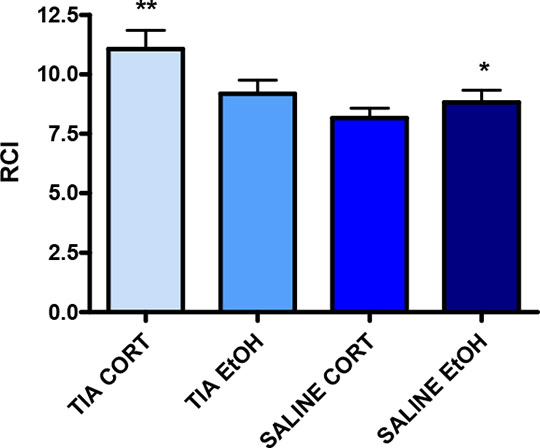Effect of Chronic Treatment with Tianeptine in Combination with Corticosterone on Rat Brain Mitochondrial Function Chronic administration of corticosterone (CORT) can mimic the morphological changes induced by prolonged stress in the hippocampus [1]. Tianeptine is a well described antidepressant with established effectiveness against stress induced deficits in the CNS. It is thought to exert its mood stabilising effects through the modulation of the glutamate transmission and influencing synaptic plasticity [2]. Depression is accompanied by impaired energy metabolism and factors affecting glutamate uptake have an impact on mitochondrial metabolism [3]. Therefore the current study aimed to explore the effect of chronic tianeptine treatment on brain mitochondrial function of male Wistar rats chronically exposed to CORT. Mitochondrial function was expressed as RCI, respiratory control index, which is a measure of the efficiency of respiratory coupling. Treatments lasted 14 days using a 2x2 factorial design, where animals (n=10) received 20mg kg-1 tianeptine, intra-peritoneally (i.p), once a day (o.d.) at approximately 10:30am. Control animals were injected with saline. Concurrently animals received CORT (5mg L-1) or ethanol (EtOH; 0.5%vv-1) orally via drinking water. On day 14 animals were decapitated, forebrain mitochondria isolated and the RCI measured polarographically using the method described by Markham et al., 2004 [4]. Data were analysed using one-way ANOVA followed by post-hoc Dunnett’s test and unpaired one-tailed student’s t-test. Animals receiving tianeptine (20mg kg-1) in combination with CORT (5mgL-1) showed a significant increase in RCI, from 7.90±0.37 to 11.07±0.78 (p<0.01; Fig 1), compared with animals receiving saline in combination with CORT. Also observed was a significant decrease in RCI of animals receiving saline in combination with CORT compared to animals receiving saline in combination with EtOH (0.5%vv-1), from 9.0±0.54 to 7.9±0.37 (p<0.05). This effect was specific to complex I supported respiration.

Figure 1 Effect of tianeteptine (20mg kg-1 i.p., o.d.; TIA) on the RCI of brain mitochondria of rats consuming 50mg L-1 CORT or 0.5% vv-1 EtOH in drinking water for 14 days, using 5 mM glutamate plus 5 mM malate (G+M) as complex I substrate. The bars represent mean ± s.e.m. (n=10; *p<0.05 & **p<0.01 compared to SalineCORT). The current study shows an increase of 40.1% in the RCI of animals receiving tianpetine in combination with CORT compared to animals receiving saline and CORT. Furthermore, this effect is specific to complex I supported respiration and is not seen in animals receiving tianeptine in combination with EtOH. A major mechanism of action of tianeptine is to act as a potentiator of glutamate neurotransmission via the AMPA receptors through the activation of MAPK and JNK pathways [2]. Previous studies confirmed that potentiation of the MAPK pathway improves the mitochondrial respiratory coupling or efficiency via complex I or glutamate supported respiration [4]. The anti-stress activity of tianeptine is achieved through the normalising of stress-induced increase of glutamate; therefore it is possible that in the absence of stress the mitochondrial function is not significantly affected by tianeptine. [1] Diamond et al., (2008). Current Neuropharmacol . 6, 311-321 [2] Szegedi et al., (2011). Neurochem. Int. 59,1109–1122 [3] Magestretti et al., (2011). J. Neurosci. 31(10), 3550–3559 [4] Markham et al., (2004). Eur. J. Neurosci. 20, 1189-119
|


